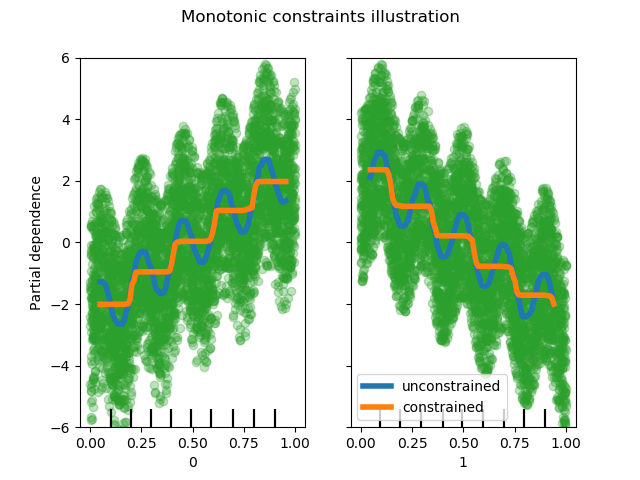单调约束¶
这个例子说明了单调约束对梯度提升估计器的影响。
我们创建了一个人工数据集,其中目标值一般与第一个特征正相关(具有一些随机和非随机变化),而在一般情况下与第二个特征呈负相关。
通过在学习过程中对特征施加正(增)或负(减)约束,估计器能够正确地跟随总趋势,而不受变化的影响。
此示例的灵感来源于 XGBoost documentation.

from sklearn.experimental import enable_hist_gradient_boosting # noqa
from sklearn.ensemble import HistGradientBoostingRegressor
from sklearn.inspection import plot_partial_dependence
import numpy as np
import matplotlib.pyplot as plt
print(__doc__)
rng = np.random.RandomState(0)
n_samples = 5000
f_0 = rng.rand(n_samples) # positive correlation with y
f_1 = rng.rand(n_samples) # negative correlation with y
X = np.c_[f_0, f_1]
noise = rng.normal(loc=0.0, scale=0.01, size=n_samples)
y = (5 * f_0 + np.sin(10 * np.pi * f_0) -
5 * f_1 - np.cos(10 * np.pi * f_1) +
noise)
fig, ax = plt.subplots()
# Without any constraint
gbdt = HistGradientBoostingRegressor()
gbdt.fit(X, y)
disp = plot_partial_dependence(
gbdt, X, features=[0, 1],
line_kw={'linewidth': 4, 'label': 'unconstrained'},
ax=ax)
# With positive and negative constraints
gbdt = HistGradientBoostingRegressor(monotonic_cst=[1, -1])
gbdt.fit(X, y)
plot_partial_dependence(
gbdt, X, features=[0, 1],
feature_names=('First feature\nPositive constraint',
'Second feature\nNegtive constraint'),
line_kw={'linewidth': 4, 'label': 'constrained'},
ax=disp.axes_)
for f_idx in (0, 1):
disp.axes_[0, f_idx].plot(X[:, f_idx], y, 'o', alpha=.3, zorder=-1)
disp.axes_[0, f_idx].set_ylim(-6, 6)
plt.legend()
fig.suptitle("Monotonic constraints illustration")
plt.show()
脚本的总运行时间:(0分0.876秒)




